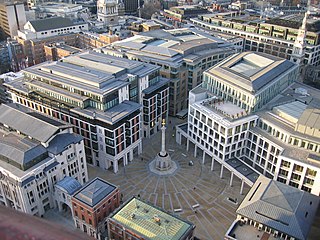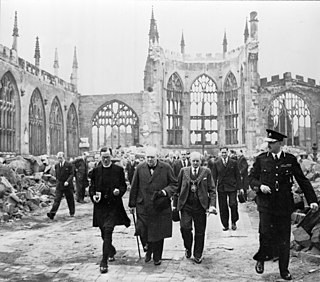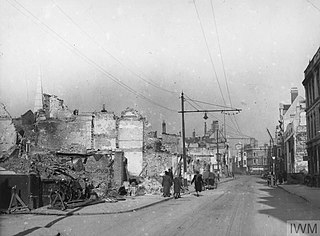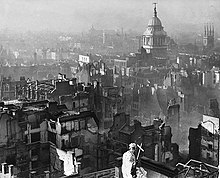
St Paul's Cathedral is an Anglican cathedral in London, England, and is the seat of the Bishop of London. The cathedral serves as the mother church of the Diocese of London. It is on Ludgate Hill at the highest point of the City of London. Its dedication in honour of Paul the Apostle dates back to the original church on this site, founded in AD 604. The present structure, which was completed in 1710, is a Grade I listed building that was designed in the English Baroque style by Sir Christopher Wren. The cathedral's construction was part of a major rebuilding programme initiated in the aftermath of the Great Fire of London. The earlier Gothic cathedral, largely destroyed in the Great Fire, was a central focus for medieval and early modern London, including Paul's walk and St Paul's Churchyard, being the site of St Paul's Cross.

Firebombing is a bombing technique designed to damage a target, generally an urban area, through the use of fire, caused by incendiary devices, rather than from the blast effect of large bombs. In popular usage, any act in which an incendiary device is used to initiate a fire is often described as a "firebombing".

A firestorm is a conflagration which attains such intensity that it creates and sustains its own wind system. It is most commonly a natural phenomenon, created during some of the largest bushfires and wildfires. Although the term has been used to describe certain large fires, the phenomenon's determining characteristic is a fire with its own storm-force winds from every point of the compass towards the storm's center, where the air is heated and then ascends.

Paternoster Square is an urban development, owned by the Mitsubishi Estate, next to St Paul's Cathedral in the City of London. The area, which takes its name from Paternoster Row, once centre of the London publishing trade, was devastated by aerial bombardment in The Blitz during World War II. It is now the location of the London Stock Exchange which relocated there from Threadneedle Street in 2004. It is also the location of investment banks such as Goldman Sachs, Merrill and Nomura Securities, and of fund manager Fidelity Investments. The square itself, i.e. the plaza, is privately owned public space. In 2004, Christopher Wren's 1669 Temple Bar Gate was re-erected here as an entrance way to the plaza.

The Liverpool Blitz was the heavy and sustained bombing of the English city of Liverpool and its surrounding area, during the Second World War by the German Luftwaffe.

The Manchester Blitz was the heavy bombing of the city of Manchester and its surrounding areas in North West England during the Second World War by the German Luftwaffe. It was one of three major raids on Manchester, an important inland port and industrial city; Trafford Park in neighbouring Stretford was a major centre of war production.

The Birmingham Blitz was the heavy bombing by the Nazi German Luftwaffe of the city of Birmingham and surrounding towns in central England, beginning on 9 August 1940 as a fraction of the greater Blitz, which was part of the Battle of Britain; and ending on 23 April 1943. Situated in the Midlands, Birmingham, the most populous British city outside London, was considered an important industrial and manufacturing location. Around 1,852 tons of bombs were dropped on Birmingham, making it the third most heavily bombed city in the United Kingdom in the Second World War, behind London and Liverpool.

The Sheffield Blitz is the name given to the worst nights of German Luftwaffe bombing in Sheffield, England, during the Second World War. It took place during nighttime on 12 and 15 December 1940.

The Coventry Blitz, or Coventration of the city, was a series of bombing raids that took place on the British city of Coventry. The city was bombed many times during the Second World War by the German Air Force (Luftwaffe). The most devastating of these attacks occurred on the evening of 14 November 1940 and continued into the morning of 15 November.

The Bristol Blitz was the heavy bombing of Bristol, England by the Nazi German Luftwaffe during the Second World War. Due to the presence of Bristol Harbour and the Bristol Aeroplane Company, the city was a target for bombing and was easily found as enemy bombers were able to trace a course up the River Avon from Avonmouth using reflected moonlight on the waters, into the heart of the city. Bristol was the fifth-most heavily-bombed British city of the war.

The Southampton Blitz was the heavy bombing of Southampton by the Nazi German Luftwaffe during World War II. Southampton was a strategic bombing target for the Luftwaffe as it contained both busy docks with associated business premises and factories and the Supermarine factory building Spitfires in Woolston. Being a large port city on the south coast it was within easy reach of German airfields in France.

Paternoster Row was a street in the City of London that was a centre of the London publishing trade, with booksellers operating from the street. Paternoster Row was described as "almost synonymous" with the book trade. It was part of an area called St Paul's Churchyard.

St Michael Paternoster Royal is a church in the City of London. The original building, which was first recorded in the 13th century, was destroyed in the Great Fire of London in 1666. The church was rebuilt under the aegis of Sir Christopher Wren. However St Michael's was severely damaged during the London Blitz in the Second World War. It was restored between 1966 and 1968.

Cyril Thomas Demarne, was a British firefighter. He served in London during the Second World War, throughout the Blitz. He was later involved in establishing aviation firefighting units in Australasia and in Beirut. In retirement, he wrote several books based on his wartime experiences.

The Hull Blitz was the bombing campaign that targeted the English port city of Kingston upon Hull by the German Luftwaffe during the Second World War.

The Nottingham Blitz was an attack by the Nazi German Luftwaffe on Nottingham during the night of 8–9 May 1941.

St Paul's Survives is a photograph taken in London during the night air raid of 29–30 December 1940, the 114th night of the Blitz of World War II. It shows St Paul's Cathedral, illuminated by fires and surrounded by the smoke of burning buildings. It was taken by photographer Herbert Mason in the early hours of 30 December, from the roof of Northcliffe House, the offices of the Daily Mail newspaper, on Tudor Street, close to Fleet Street.

The term Bath Blitz refers to the air raids by the German Luftwaffe on the British city of Bath, Somerset, during World War II.

The term Exeter Blitz refers to the air raids by the German Luftwaffe on the British city of Exeter, Devon, during the Second World War. The city was bombed in April and May 1942 as part of the so-called "Baedeker raids", in which targets were chosen for their cultural and historical, rather than their strategic or military, value.
The Norwich Blitz refers to the heavy bombing of Norwich and surrounding area by the German Luftwaffe during World War II. The bombings launched on numerous British cities were known as the Blitz.





















